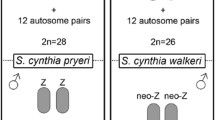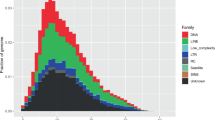Abstract
To analyze the degree of pairing of the Z and W chromosomes in ZZWW tetraploid female silkworms that have the W chromosomes of the domesticated silkworm, Bombyx mori, and those of the wild silkworm, Bombyx mandarina, we induced two types of ZZWW tetraploid female silkworms (Cr4n, Wr4n) through cold treatment of the eggs. The Wr4n female is congenic to the Cr4n female for W chromosomes; namely, the W chromosomes of the Wr4n female are derived from those of B. mandarina. Each of the sex ratios (♀/♂) in filial triploids from the Cr4n females was shown to be in the range of 3.9–5.3 (4.6 as an average of six cases). On the other hand, each of the sex ratios (♀/♂) in filial triploids from the Wr4n females was shown to be in the range of 6.2–9.0 (6.9 as an average of nine cases). The results of a t-test indicated that the difference in sex ratios in the two groups is highly significant (at the 0.1% level). These results suggest that, in the meiosis of the ZZWW tetraploid female, the frequency of pairing of the W chromosome of B. mandarina and the Z chromosome of B. mori is lower than that of the pairing of the W and Z chromosomes of B. mori. Furthermore, the t-test results are evidence that the W chromosomes have undergone significant evolutional change.
Similar content being viewed by others
References
Abe, H., M. Kanehara, T. Terada, F. Ohbayashi, T. Shimada, S. Kawai, M. Suzuki, T. Sugasaki & T. Oshiki, 1998. Identification of novel random amplified polymorphic DNAs (RAPDs) on the W chromosome of the domesticated silkworm, Bombyx mori, and the wild silkworm, B. mandarina, and their retrotransposable element-related nucleotide sequences. Genes Genet. Syst. 73: 243–254.
Abe, H., F. Ohbayashi, T. Shimada, T. Sugasaki, S. Kawai, K. Mita & T. Oshiki, 2000. Molecular structure of a novel gypsy-Ty3-like retrotransposon (Kabuki) and nested retrotransposable elements on the W chromosome of the silkworm Bombyx mori. Mol. Gen. Genet. 263: 916–924.
Hasimoto, H., 1933. Genetical study on the tetraploid female silkworm. Bull. Imp. Seric. Exp. Sta. Jpn 8: 359–381.
Hasimoto, H., 1953. Forigo de vir-sekso, Kozo de eksterordinara seksratio ce lamorusa silkraupo, Bombyx mori. J. Seric. Sci. Jpn 22: 175–180.
Ito, S., 1977. Cytogenetical studies on the chromosome of silk gland cells of the silkworm with special reference to structure and behavior of the sex chromosomes. Jpn J. Genet. 52: 327–340.
Kawaguchi, E., 1928. Zytologische Untersuchungen am Seidenspinner und seinen Verwandten. I. Gametogenese von Bombyx mori L. und B. mandarina M. und ihrer Bastarde. Z. Zxellforsch. Mikrosk. Anat. 7: 519–552.
Kawaguchi, E., 1934. Chromosome behaviour in tetraploid female of the silkworm. J. Seric. Sci. Jpn 5: 73–79.
Kawamura, N., 1979. Polyploidy and size of serosa nuclei and cells in eggs of the silkworm, Bombyx mori. J. Seric. Sci. Jpn 48: 23–36.
Kawamura, N., 1988. Egg size determining gene, Esd, is a unique morphological marker on the W chromosome of Bombyx mori. Genetica 76: 195–201.
Kawamura, N., K. Sahara & T. Iizuka, 1994. Preferential pairing of sex chromosomes in the tetraploid silkworms (Bombyx mori). Hereditas 121: 73–78.
Marec, F. & W. Traut, 1993. Analysis of structural rearrangements of Lepidoptera chromosomes using the centrifugation spreading technique, pp, 243–250 in Management of Insect Pests: Nuclear and Related Molecular and Genetic Techniques, edited by P. Howard-Kitto, R.F. Kelleher & G.V. Ramesh. IAEA, Vienna.
Marec, F. & W. Traut, 1994. Sex chromosome pairing and sex chromatin bodies in W-Z translocation strains of Ephestia kuehniella (Lepidoptera). Genome 37: 426–435.
Murakami, A. & H.T. Imai, 1974. Cytological evidence for holocentric chromosomes of the silkworms, Bombyx mori and B. mandarina, (Bombycidae, Lepidoptera). Chromosoma 47: 167–178.
Sahara, K., N. Kawamura & T. Iizuka, 1990. Analysis of the sex chromosome pairings in tetraploid females of the silkworm by using the sex-linked recessive gene. J. Seric. Sci. Jpn 59: 196–201.
Sahara, K., B. Falakali, N. Kawamura & T. Iizuka, 1995. Preferential pairing of sex chromosomes in homotype and heterotype 94 tetraploid silkworm females of sex-limited normal pattern strain, HOMARE. J. Seric. Sci. Jpn 64: 380–384.
Sasaki, C., 1898. On the affinity of our wild and domestic silkworms. Ann. Zool. Jpn 2: 2.
Tanaka, Y., 1916. Genetic studies in the silkworm. J. Coll. Agric. Sapporo 6: 1–33.
Tanaka, Y., 1939. Non-disjunction of the sex-chromosomes in the silkworm. Jpn J. Genet. 15: 359–361.
Tazima, Y., 1944. Studies on chromosome aberrations in the silkworm. II. Translocation involving second and W-chromosomes. Bull. Seric. Exp. Sta. Jpn 12: 109–181.
Tanaka, N., T. Yokoyama, O. Ninagi, H. Abe & T. Oshiki, 1999. The effect of translocated second-chromosome fragments on sex chromosome pairings in ZZWW tetraploid female silkworm, Bombyx mori. J. Seric. Sci. Jpn 68: 315–319.
Tamazawa, S. & T. Takizawa, 1977. On the polyploid induced by supercooling treatment of the eggs of the silkworm, Bombyx mori L. The relation between the enlargement of the serosa cells and polyploidy. Memo. Fac. Agric. Hokkaido Univ. 10: 272–283.
Traut, W. & F. Marec, 1996. Sex chromatin in Lepidoptera. Quart. Rev. Biol. 71: 239–256.
Weith, A. & W. Traut, 1986. Synaptic adjustment, non-homologous pairing, and non-pairing of homologous segments in sex chromosome mutants of Ephestia kuehniella (Insecta, Lepidoptera). Chromosoma 94: 125–131.
Yokoyama, T. & T. Oshiki, 1992a. Abnormal segregation of characters in the progeny hatched from giant eggs oviposited by a gynogenetic tetraploid moth mated with a normal male moth in Bombyx mori. J. Seric. Sci. Jpn 61: 300–305.
Yokoyama, T. & T. Oshiki, 1992b. Abnormal segregation of characters in the progeny hatched from giant eggs oviposited by a gynogenetic tetraploid moth mated with a normal male moth in Bombyx mori (suppl.). J. Seric. Sci. Jpn 61: 520–521.
Author information
Authors and Affiliations
Rights and permissions
About this article
Cite this article
Tanaka, N., Yokoyama, T., Abe, H. et al. The Effect of W Chromosome Origin on Sex-Chromosome Pairing in ZZWW Tetraploid Females of the Domesticated Silkworm, Bombyx Mori, and the Congenic Wild Silkworm, Bombyx Mandarina . Genetica 114, 89–94 (2002). https://doi.org/10.1023/A:1014638723413
Issue Date:
DOI: https://doi.org/10.1023/A:1014638723413




